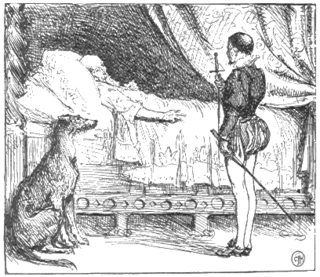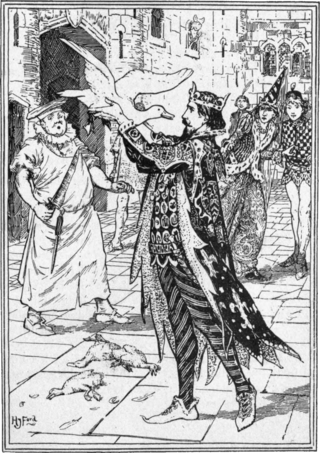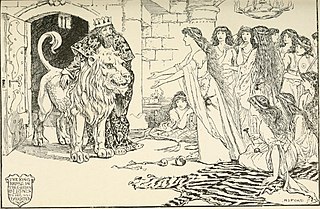Citations
Literature
- Gun Herranen (1990), "Hackman, Walter Oskar", Enzyklopädie des Märchens (in German), vol. 6, col. 350–351
Related Research Articles

Walter Arthur Alexander Anderson was a Baltic German ethnologist (folklorist) and numismatist.

Antti Amatus Aarne was a Finnish folklorist.
The Aarne–Thompson–Uther Index is a catalogue of folktale types used in folklore studies. The ATU Index is the product of a series of revisions and expansions by an international group of scholars: originally composed in German by Finnish folklorist Antti Aarne (1910), the index was translated into English, revised, and expanded by American folklorist Stith Thompson, and later further revised and expanded by German folklorist Hans-Jörg Uther (2004). The ATU Index, along with Thompson's Motif-Index of Folk-Literature (1932)—with which it is used in tandem—is an essential tool for folklorists.

"Trusty John", "Faithful John", "Faithful Johannes", or "John the True" is a German fairy tale collected by the Brothers Grimm and published in Grimm's Fairy Tales in 1819. Andrew Lang included it in The Blue Fairy Book.

The White Duck is a Russian fairy tale collected by Alexander Afanasyev in Narodnye russkie skazki. Andrew Lang included it in The Yellow Fairy Book.

Julius Leopold Fredrik Krohn was a Finnish folk poetry researcher, professor of Finnish literature, poet, hymn writer, translator and journalist. He was born in Viipuri and was of Baltic German origin. Krohn worked as a lecturer on Finnish language in Helsinki University from the year 1875 and as a supernumerary professor from 1885. He was one of the most notable researchers into Finnish folk poetry in the 19th century. His native language was German.

The Golden Lion is an Italian fairy tale collected by Laura Gonzenbach in Sicilianische Märchen. Andrew Lang included it in The Pink Fairy Book.

The Mermaid and the Boy is a Sámi fairy tale first collected in the mid-19th century. It tells the story of a prince unknowingly promised to a mermaid before he was born, then obtains magical powers to transform into animals later in the story.

Kaarle Krohn was a Finnish folklorist, professor and developer of the geographic-historic method of folklore research. He was born into the influential Krohn family of Helsinki. Krohn is best known outside of Finland for his contributions to international folktale research. He devoted most of his life to the study of the epic poetry that forms the basis for the Finnish national epic, the Kalevala.
The Story of Bensurdatu is an Italian fairy tale collected by Laura Gonzenbach in Sicilianische Märchen. Andrew Lang included it in The Grey Fairy Book.

The Princess Who Never Smiled, The Unsmiling Tsarevna or The Tsarevna who Would not Laugh is a Russian folk fairy tale collected by Alexander Afanasyev in Narodnye russkie skazki, as tale number 297.

The Norka is a Russian and Ukrainian fairy tale published by Alexander Afanasyev in his collection of Russian Fairy Tales, numbered 132.

Little Wildrose is a Romanian fairy tale. Andrew Lang included it in The Crimson Fairy Book.
Hans-Jörg Uther is a German literary scholar and folklorist.
In folkloristics, "The Animal as Bridegroom" refers to a group of folk and fairy tales about a human woman marrying or being betrothed to an animal. The animal is revealed to be a human prince in disguise or under a curse. Most of these tales are grouped in the international system of Aarne-Thompson-Uther Index under type ATU 425, "The Search for the Lost Husband". Some subtypes exist in the international classification as independent stories, but they sometimes don't adhere to a fixed typing.
The Story of The Farmer's Three Daughters is an Icelandic fairy tale collected by author Jón Árnason in his 1864 compilation of Icelandic tales and legends. It is related to the theme of the calumniated wife and classified in the Aarne-Thompson-Uther Index as type ATU 707, "The Three Golden Children".

The Dog in the Sea, also known as The Dog and the Sailor is a northern European fairy tale classified as ATU 540, "The Dog in the Sea".
The Beautiful Palace East of the Sun and North of the Earth is a Swedish folktale collected from Smaland by Swedish folktale collectors George Stephens and Gunnar Olof Hyltén-Cavallius. It features versions of the swan maiden, a mythic female character that alternates between human and animal shapes.
The Man and the Girl at the Underground Mansion is a Danish folktale collected by theologue Nikolaj Christensen in the 19th century, but published in the 20th century by Danish folklorist Laurits Bodker.
Skrifter utgivna av Svenska litteratursällskapet i Finland is a book series in Swedish published in Finland since 1886 by the Society of Swedish Literature in Finland (SLS). The main series reached number 734 in the year 2010. The series has several sub-series with own themes and numbering. Several of the publications have been digitised and made freely available by the National Library of Finland.
References
- ↑ Kai Laitinen (1973), Aino Kallas 1897–1921 (in German), Helsinki: Otava, p. 177, ISBN 951-100677-0
- 1 2 Krohn-suvun haarat
- ↑ Antti Aarne (1910), Verzeichnis der Märchentypen, Suomalaisen Tiedeakatemian toimituksia. FF Communications 3 (in German) (1. ed.), Helsinki: Druckerei der Finnischen Litteraturgesellschaft, pp. X